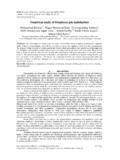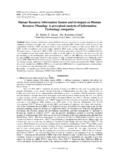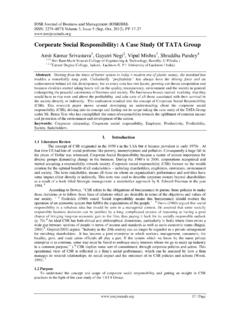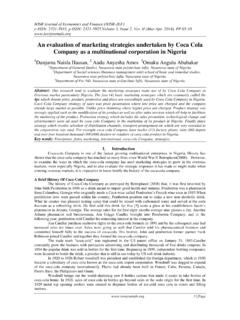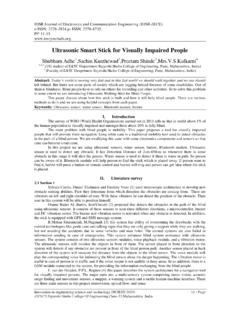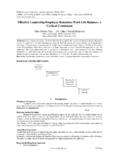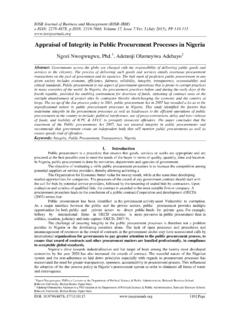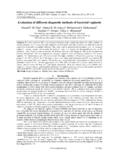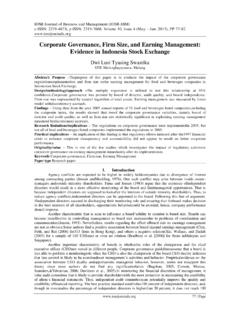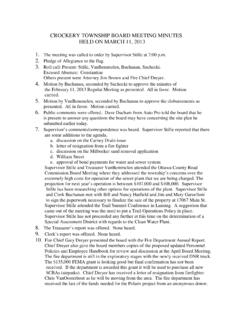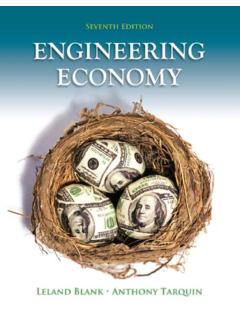Transcription of Challenges Facing Micro and Small Enterprises in …
1 IOSR Journal of Business and Management (IOSR-JBM). e-ISSN: 2278-487X, p-ISSN: 2319-7668. Volume 13, Issue 5 (Sep. - Oct. 2013), PP 20-29. Challenges Facing Micro and Small Enterprises in Inventory Management in Kisii Town, Kenya Fred Ongisa Nyang au, Jomo Kenyatta University of Agriculture and Technology -Kenya Abstract: This study focused on the Challenges Facing Micro and Small Enterprises (MSEs) in inventory management in Kisii Town, Kenya. The objective of the study was to evaluate the Challenges Facing MSEs in inventory management in Kisii Town-Kenya. Some of the inventory management Challenges include demand variability, material handling, inventory costs, inadequate information and stock setting. The accessible population was the three hundred and eight (308) registered MSEs in Kisii Town. The study used stratified random sampling to group the businesses into homogeneous entities.
2 A random sample was then drawn from the each group. Questionnaire with both open and closed items used to obtain data. Correlation analyses were used to ascertain the relationship between inventory Challenges and effective inventory management in MSEs. The study established the existence of a strong negative relationship between demand variability, inadequate information sharing and inventory costs and inventory management. Key Words: Challenges , forecast, inventory, lead time, Micro and Small Enterprises and stock out I. Introduction This study was on the Challenges Micro and Small Enterprises (MSEs) face in inventory management. Getting a universally acceptable definition of MSE has been challenging. However, some features have been used variously to define these entities. These characteristics are the number of employees, the amount of initial capital investment, the value of assets, the size of the business premises and annual turn over (Hamisi, 2010.)
3 Kauffmann, 2005; Bowen et ). According to Association of enterprise Opportunity (AEO), a microenterprise is a type of Small business with less than 5 employees and a seed capital of less than US $ 35. 000. In addition, various journals report that for developed countries, Micro and Small Enterprises (MSEs) are those business entities with no more than 100 employees. It further reports that United States adopted Micro and Small Enterprises from the developing countries with a view to attaining social justice for the marginalized. Currently MSEs represent the smallest business entities in the developed nations. In Kenya, although Micro and Small Enterprises existed before, they gained prominence in the 1990s largely because the World Bank and the International Monetary Fund advocated for structural adjustment programs (SAPs).
4 The programs encouraged liberalization and privatization of the country s economy;. consequently, massive job losses. The terminal benefits were invested in informal businesses which proved a big success in job and wealth creation (House, 2009; Prasad et al. 2010; Chu et al. 2007). The 1999 Kenya National Micro and Small Enterprises Baseline Survey established that MSEs contributed about of the country s Gross Domestic Product (GDP) because of jobs were in the MSE subsector. Kenya (1999) defined Micro , Small and medium Enterprises (MSMEs) as those in any business in the private sector which employ not more than 50 employees. Micro , Small and Medium Enterprises Act [MSME], 2013 adopts two metrics to define non manufacturing and production MSEs: the number of employees and the annual sales volume. Those Enterprises with an annual turn over of less than US $ 60 000 and employees not exceeding 50 can be described as Micro and Small Enterprises .
5 Although a universal working definition of MSE has not been achieved, these businesses show universal characteristics (Hatten, 2012; Mbithi and Mainga, 2006; Sandu [1997, cited in Lobontieu, 2001). Micro and Small businesses;. a) Are often owner- managed with few employees, b) Are labour intensive because of low absorption of technology, c) Have unpredictable cash flows and uncontrolled costs, d) Are flexible, and e) May advance to more sustainable businesses. It is worth noting that since the initiation of Millennium Development Goals, commonly known as MDGs, and the Kenya Vision 2030, the government has attempted to support MSEs through various pieces of legislation such as Investment Promotion Act, 2004; Public Procurement and Disposal Act, 2006 and Micro , Small and Medium Enterprises Bill, 2009 (Mbithi and Mainga, 2006).]
6 Towards this end, MSEs are expected to continue playing vital economic role especially in new job and wealth creation. According to Kenya Economic Survey 2011, MSEs contributed of new jobs and accounted for 18% of the Gross Domestic Product (GDP). The 20 | Page Challenges Facing Micro And Small Enterprises In Inventory Management In Kisii Town, Kenya successful implementation of the Economic Recovery Strategy for Wealth and Employment Creation which saw the country grow economically from in 2002 to GDP in 2006 hinged on MSEs (Kenya, 2005). This was because the government emphasized on poverty reduction through its Sessional Paper No. 2 of 2005 on Development of Micro and Small Enterprises for Wealth and Employment Creation for Poverty Reduction. Evidence suggest that Kenya s economy consists of about 900 000 MSEs in diverse fields such as mining, manufacturing, production services, distribution and retailing (Chu et al.)
7 2007). Of these 50% are in retail and commerce while 30% participate in manufacturing and production service. Mbithi and Mainga (2006). indicated that the number of MSEs has over the years risen because of the availability of relatively cheap loans courtesy of Youth Development Fund, Women enterprise Fund, microfinance institutions, faith-based organizations and other non-governmental organizations (NGOs). From the foregoing discussion, it is clear that the government has created statutory environment to cushion against financial, legal and tax- related Challenges . However some Challenges are inherently difficult to legislate against because Kenya is a liberalized economy. These constraints include cut throat competition, unpredictable demand patterns, changing customer preferences and others (Bowen, Morara and Mureithi, 2009.
8 Chopra, Meindl and Kalra, 2007). These Challenges require businesses to respond to specific customer demands in order to have a competitive advantage. Thus, the role of supply chain (SC) and inventory management in gaining that advantage is recognized by (Gunisekaran and Ngai, 2004). This paper defines inventory management as planning, implementation, evaluation and control of any quantifiable items used, stored, sold or transported by a business organisation. Inventory management is a major issue in SCM because it helps to eliminate wasteful and expensive inventory (Routroy and Kodali, 2005; Alande et al. 2004). Effective inventory management is critical to the successful management of MSEs. Robinson, Logan and Salem (1985) demonstrated that inadequate inventory planning has been one of the major causes of Small business failure.
9 Equally, inventory management policies are critical in determining the profitability of businesses, especially those whose inventory represents about 20% to 60% of their total assets (Arnold, 1998). II. Literature Review Theoretical framework The two main inventory theories in inventory management are: inventory management theory which is also known as mathematical inventory theory and the theory of constraints. There are several mathematical models/ theories in inventory management depending on the predictability of demand (Heizer and Render, 2006). The two common models in scientific inventory theory are deterministic and stochastic inventory models. According to Morgenstern (2007), when demand in future can be determined through forecasting with some precision, deterministic model would be used to set inventory policy.
10 Stochastic, on the other hand, is used where the demand in a given period is variable- cannot be predicted. Theory of Constraints (TOC) is a management philosophy developed by Goldratt (1984) in his book, The Goal. It postulates that an organization is a system, and every system has at least one constraint limiting it from achieving its goal of making (more) money. In order to improve the performance of the system, these constraints must be identified (described) and corrective measures taken (a prescription). Identifying the constraints help to focus the limited resources to the weakest part for the system to improve. Fig. 1 shows the three ways to the ultimate goal: throughput (T), inventory (I) and operating expenses (OE). A system can, therefore, be evaluated and controlled by the three. Throughput is defined as the rate at which the system generates revenue through sales.

